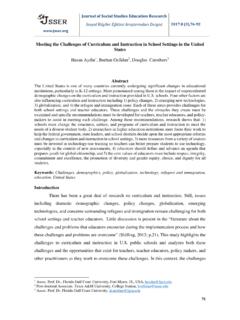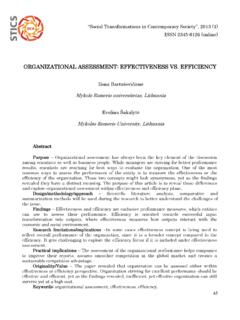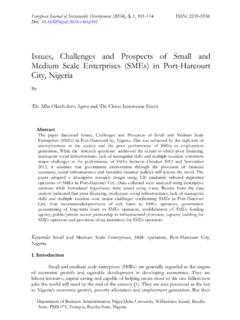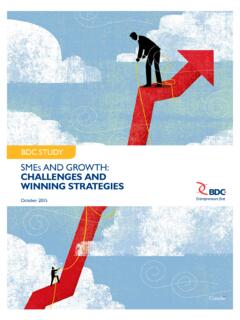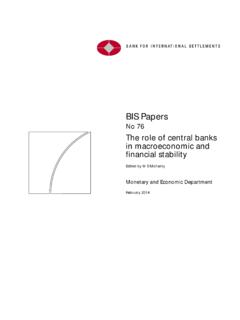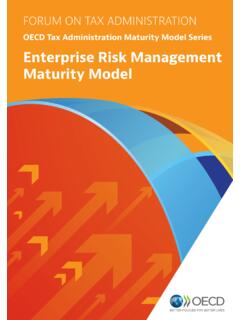Transcription of Main Trends & Challenges in the Space Sector
1 December 2020 Main Trends & Challenges in the Space Sector2ndEditionVersion Updated 05/03/2021 Introduction05 Major Trends in the Space sector09 Earth Observation15 Satellite communication21 Navigation25 Access to space29 Space Situational Awareness35 Space exploration37 Space law, regulation & procedures41 PwC dedicated Space practice with leading edge insights and global reachLearn a global reach, and a dedicated strategy and policy team based in Paris and Toulouse, the PwC Space Practice is unique among large professional services firms. It combines focused Space expertise with a significant reach into the broader downstream. 2 The core Space team is currently involved in assignments for public and private entities inEurope and core team notably works on strategy assignments ( market sizing, go-to-market, business plan development, commercial due diligence, etc.)
2 ,commercial due diligences and support to M&A,socio- economic impact assessments related to public investment in Space , analysis of governance & organizational structure (at programme, company or country level) and regulatory analysis ( impact of existing & prospective regulations, assessment of regulatory requirements in the cycle market-regulation, etc.)4 With the PwC Data Lab an entity from PwC France specialised in the development of innovative applications we provide services (PwC Insights from Space ) using Space data to public and private decision-makers (often non-familiar with the Space -based data derived capabilities).5 The PwC Space Practice is part of the wider PwC Aerospace and Defence network which is composed of more than 2,000 consultants in the Space PracticeRecent publicationsThe PwC/Strategy& Space Practice in 5 pointsMarket perspectives of Ground Segment as a ServiceNovember 2020 Provides a comprehensive understanding of GSaaS, its current context, market and its potential evolution in the future.
3 It explores the market drivers that could impact the GSaaS market in the future and assesses their potential and Challenges in the Space sectorOctober 2020On the occasion of the Indian International Space Conference, we have published a report on the current Trends and Challenges in the Space Sector , with a specific focus of the Indian Space of the Space Sector to the COVID-19 CrisisApril 2020 Provides an assessment of the impacts and resilience to the COVID-19 crisis of the various domains in the Space Space NationsMarch 2020 Provides an understanding of the role of emerging Space nations in supporting sustainable development and economic 2020 PwC - Space Practice Space Sector is driven by complex macro-level dynamics that go beyond simple market forces, requiring an holistic viewIntroductionSource: PwC analysis.
4 Image Credits: CNES, Arianespace, NASAThe Main Trends & Challenges in the Space Sector (2nd Edition) provides PwC Space Practice views on major Trends and dynamics impacting the civil and commercial Space Sector document is organised into 8 sections: an introduction to macro Trends impacting the Space Sector ; 6 dedicated chapters per Space domain; and a closing section on governance, policy and regulation. Multiple domains with different Trends and specificities An ever evolving regulatory and policy environment A significant reach and implications into other industrial Sector , with subsequent dependency on general macro- Trends Considerable wider societal and economic impacts, justifying the still prevalent government spending in the sectorGovernance, policy and regulation Macro Trends in the Space sectorAccess-to-spaceEarth Observation NavigationSatcomSpace Situational AwarenessSpace ExplorationSpace domains trends1.
5 Table of Content/Scope2. The Space Value Chain3. Space Market Sizing4. Trends at a GlanceA Sector with multiple specificities5 December 2020 PwC - Space Practice on ScopeThe present document focuses on civil and commercial Space , only providing some minor pointers touching military Space . As such, it should not be considered comprehensive or representative of Trends related to military Space and separate piece of thought leadership dedicated to Space and defenseis currently being prepared by PwC. Space is experiencing significant mindshare growth, as well as increasing implications in multiple downstream industriesSource: PwC analysisIntroductionConsumer, industry, governments, non-profit organisationsA variety of sectors (energy, infrastructure, agriculture, marine, defence and security, Location-Based Services, etc.)
6 Launch systems and vehiclesSatellite AIT and manufacturingGround segment systems and network equipment ( gateways, VSAT, etc.)Launch service provision, satellite and ground segment operationData and satellite services (direct-to-home, broadband, navigation, etc.)Value-added servicesUser equipment ( GNSS devices and chipsets, TV dishes, radio receivers, etc.)Source: PwC analysisUpstreamDownstreamEnd users The Space value chain is evolving, with the traditional upstream driven technology push (upstream creates new applications for the downstream market to follow) transitioning into a market demand pull (downstream drives Space systems development with needs for new services) Space has attracted an important number of actors in the past decades, with New Space and non- Space companies entering the different streams of the value chain Space retains its status as a halo Sector , with positive impacts and spillovers over a large pool of end users, in the global economyTechnology push Applications User demand pull ServicesSystem &infrastructureOperationData & ProcessingAdvanced products & servicesKey take-aways1.
7 Table of Content/Scope2. The Space Value Chain3. Space Market Sizing4. Trends at a Glance6 December 2020 PwC - Space Practice of companies (non-exhaustive)Example of companies (non-exhaustive)Examples (non-exhaustive)Sizing the global Space economy is a complex exercise due to the lack of a unified taxonomy and difficulties in setting up boundaries Space is not recognised as a category in international standards of industrial classification. Therefore, worldwide market sizing studies differ in definition, coverage and methodology. This makes it difficult to compare the results in global estimates. The boundaries between Space and non- Space activities are often blurred, leading to different ways of assessing the overall Space economy. This is specifically critical when setting the boundary between the downstream Space industry and end-user economy: as the analysis moves down the value chain, the assessment of the direct causal relationship(called paternity) between the Space industry and the benefits brought to end-users become complex to isolate and accurately measured.
8 Indeed, benefits derived from Space tend to only represent a tiny part of the value created for end-users. Given the above, when considering global and regional figures related to Space market sizing, it is extremely important to understand what they encompass in their perimeter. Commercial revenues (USD Bn): Space infrastructure (USD Bn); Space products & services (USD Bn); Governmental spending (USD Bn).Source: Space Foundation, 2020 USD Bn (2020) Satellite Services (USD 123 Bn): telecommunications, remote sensing, science & national security; Ground Equipment (USD Bn): network & consumer equipment; Government Space Budgets & Commercial Human Spaceflight (USD 95 Bn):non-satellite industry; Satellite Manufacturing (USD Bn); Launch Industry (USD Bn).
9 Source: Bryce, 2019 USD 366 Bn (2019)This figure refers to commercial satellites revenues only: Upstream (USD 8 Bn): satellite manufacturing, satellites launch, ground equipment manufacturing; Downstream (USD 290 Bn): satellite operation, : Euroconsult, 2018 USD 298 Bn (2019) Upstream (USD 23 Bn): launch services; satellite manufacturing Midstream (USD 40 Bn): ground infrastructure & operations; fleet ops Downstream (USD 226 Bn): consumer equipment, Space services Institutional budgets (USD 82 Bn): research Space exploration; military; : PwC, 2020 USD 371 Bn (2020)Market estimateNotes on the assessed perimeter and granularityMeasuring the Space economySourcesIntroduction1. Table of Content/Scope2. The Space Value Chain3. Space Market Sizing4. Trends at a Glance7 December 2020 PwC - Space Practice COVID-19 crisis has mainly impacted operational and manufacturing activities during country-wide and partial lockdowns.
10 These resulted in programme delays and financial strain on small and medium enterprises. Heavily tied to institutional budgets, the Space Sector is expected to be impacted by changing government priorities and agendas, with sizeable knock-on effects from other industrial that are combining multiple digital technologies such as Cloud, Artificial Intelligence, Additive Manufacturing or Blockchain tend to have a high competitive advantage in the Sector . These technologies give rise to more scalable and innovative business models with more customer-oriented approaches, and push for the democratization of the access to the Space cutting macro- Trends and main Trends per domain at a glanceEarth ObservationWhile the EO domain remains geared towards defence and security markets, an increasing demand from a diversified pool of customers is leading the rapid evolution of Earth Observation, with more supply from new entrants, and innovative delivery models for data and analytics to support situational communicationsDemand from new market segments (mobility, IoT, M2M and ubiquitous connectivity) is transforming the satcom domain.


